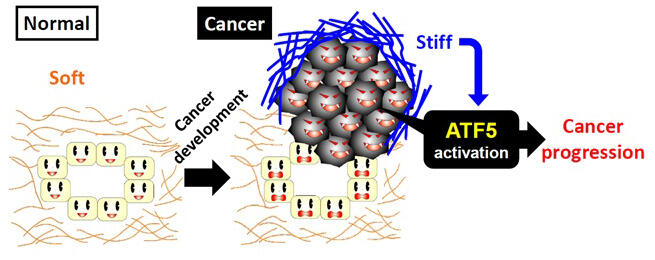A research group led by Assistant Professor Seiichiro Ishihara and Professor Hisashi Haga from the Faculty of Advanced Life Science at Hokkaido University, Professor Atsushi Enomoto from the Graduate School of Medicine at Nagoya University, Akihiro Sakai (who was a graduate student at the time of the research) from the Graduate School of Life Science at Hokkaido University, and Associate Professor Motoaki Yasuda from the Faculty of Dental Medicine at Hokkaido University has announced their discovery that tissue "stiffness" significantly influences cancer progression. They found that cancer cells that sense "stiffness" enhance the function of a molecule called ATF5, making them more likely to proliferate. They also discovered that inhibiting this molecule makes both pancreatic cancer cells and lung cancer cells less likely to proliferate. This finding is expected to lead to the development of new treatment methods. Their results were published in the international scientific journal iScience on February 17, 2025.

Provided by Hokkaido University
Cancer has long been known as a disease that creates stiffened areas or lumps in tissues. However, it was not previously understood whether this "stiffness" itself affects the progression of the disease.
In this study, when pancreatic cancer cells were placed on both soft and stiff substrates, the researchers discovered differences in the distribution of a molecule called ATF5 within the cells.
ATF5 is a protein that exists within cells and has been reported to be abundant in cancer cells, though its function was not well understood. While ATF5 is distributed almost uniformly throughout cells on soft substrates, on stiff substrates it concentrates in the nucleus. The results showed that by gathering in the nucleus, ATF5 functions more strongly and that stiff substrates enhance ATF5 activity. When ATF5 was suppressed through RNA interference, the researchers found that the number of cells decreased in both pancreatic and lung cancer cells, suggesting that inhibiting ATF5 could be effective for cancer treatment.
The researchers then examined surgical specimens from pancreatic cancer patients, observing ATF5 distribution in three areas: normal pancreatic tissue, soft regions of pancreatic cancer, and stiff regions of pancreatic cancer. The results showed that ATF5 was barely present in normal pancreatic tissue. Furthermore, compared to soft regions of pancreatic cancer, ATF5 was more concentrated in the nuclei of cells in stiff regions, indicating enhanced ATF5 activity. Since many cancers are "stiff," ATF5 may potentially worsen various cancers beyond pancreatic and lung cancer by being enhanced due to stiffness.
Ishihara commented: "By focusing on the ATF5 molecule, we were able to clarify one aspect of the mechanism by which stiffness worsens cancer. In the future, we would like to develop new cancer treatments based on this discovery. We will continue to conduct research that can provide hope for cancer patients."
Journal Information
Publication: iScience
Title: Stiff extracellular matrix activates the transcription factor ATF5 to promote the proliferation of cancer cells
DOI: 10.1016/j.isci.2025.112057
This article has been translated by JST with permission from The Science News Ltd. (https://sci-news.co.jp/). Unauthorized reproduction of the article and photographs is prohibited.




